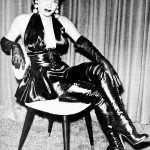I’m currently reading Peter Stallybrass’ and Allon White’s The politics and poetics of Transgression (Cornell University Press, 1986), which is largely based on Bakhtin’s concept of the carnivalesque. BDSM certainly fits the definition of a world turned inside out and upside down, where people chose their roles from a variety of options. The old become young (ageplay and infantilism), men become women and women become men (genderplay), the weak become strong (femdom), rape becomes love (rape play), confinement becomes freedom and pain becomes pleasure.
I think that a lot of fetishes involved taking the classical body and making it grotesque: messy, dirty, exaggerated, contorted, fat, hairy, overmuscled, etc. Or taking a classical body and making it even more classical: the doll/robot/statue/hypnosis cluster of fetishes.
But is the BDSM culture truly carnivalesque? Is there really such a culture? I’ve always thought that all human cultures, from a Japanese corporate boardroom to a biker gang party, have etiquette, rules you have to follow or you get censured or expelled. Outsiders look at play parties and see a chaos of bodies rendered grotesque, but anybody on the inside knows that BDSM has a carefully developed system of etiquette and ethics. Your typical BDSM scene is not an “unruly space”, but an event as well-planned and orderly as a visit from the Queen.
Maybe I’m misinterpreting “carnival.” Or maybe BDSM is “the marriage of heaven and hell” (to quote William Blake) which gives us the freedom of the carnival without some of the downsides: “…carnival often violently abuses and demonizes weaker, not stronger, social groups – women, ethnic and religious minorities, those who ‘don’t belong’ – in a process of displaced abjection…” (Pg.19, emphasis in original).
Carnivalesque is an interesting idea with which to look at popular culture. Rock’n’roll used to be carnivalesque, but that was a while back. The cultural forms that do manage to be truly carnivalesque are gangsta rap and pornography.
Stallybrass and White’s book “The Politics and Poetics of Trangression” has introduced me to a carnivalesque sub-genre of books and illustrations, “The World turned upside down.”
One anonymous book (no date, either) has illustrations (woodcuts?) with accompanying bits of doggerel verse. For example:
To see a cat steal milk from a pan, is no news;
But to see a buck hunting a man, is strange indeed!
Hark forward, huzza,
He can’t get away:
And he’s not buck enough
To stand at a bay.
To see a good boy read his book, is no news;
But to see a goose roasting a cook, is strange indeed!
I’ll roast ye, and baste ye,
But who will may taste ye.
A common theme in this genre is inversion of the categories of animal and human, but there are other inversions too. An anonymous lithograph, c.1830, shows men pulling plows and carriages with horses wielding whips, a beggar without a leg giving money to a well-dressed man, a lady sweeping the floor while a maid sits and plays the guitar, a little girl tends to a grown woman in a crib, and so on.
I don’t know if these works were considered sexual when they were made. I suspect they’re more about humor than eroticism. However, the comparisons between BDSM activities (ponyplay, infantilism, etc) as well as the idea of class inversion, that a master would play the role of a servant. Perhaps these illustrations were a prototype for fetish pornography, hinting at the fantasy of becoming something else.





